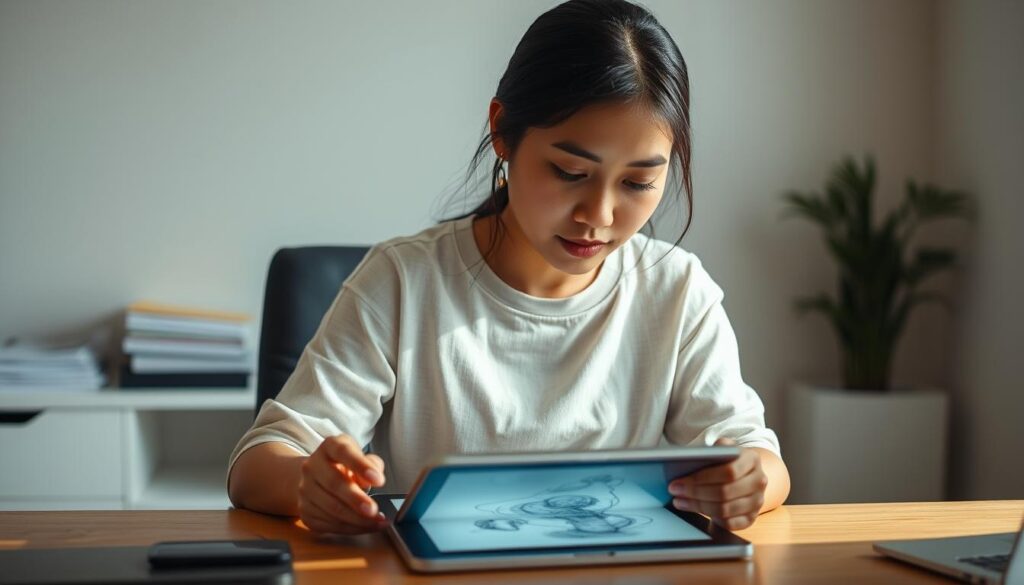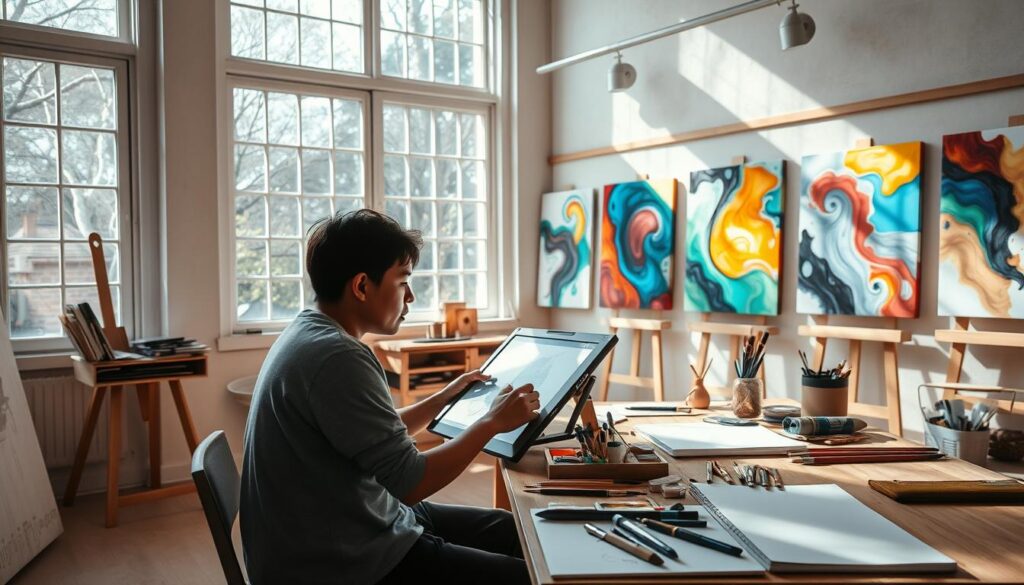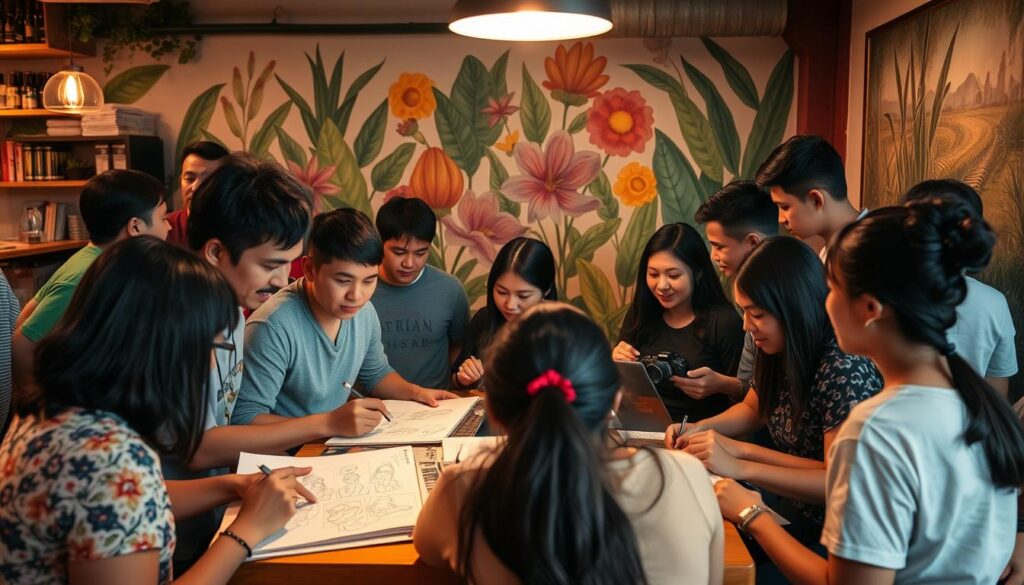Have you ever wondered how a machine can create art, music, or stories as good as humans?
Generative AI platforms lead the way in innovation, changing how we create. Since ChatGPT came out in 2022, these tools help users make everything from simple emails to detailed content. They make the creative process easier, saving teams time to grow instead of doing the same tasks over and over.
In a world where AI meets creativity, generative AI tools are changing the game. This article looks at how these tools can help business leaders in Southeast Asia. It shows their power and how they can change creative projects.
The journey into generative AI is just starting. The insights here will inspire you to try these new solutions.
Key Takeaways
- Generative AI platforms boost creativity by letting users make different content fast.
- These tools cut down time on routine tasks in creative work.
- Knowing about generative AI is key to using these tools well.
- The effect of generative AI is seen in many creative fields, from art to business design.
- As tech gets better, using these new tools can help you grow in the future.
What is Generative AI?
Generative AI is a big change in how machines make content. It lets systems create text, images, music, and more using smart algorithms. Understanding it starts with knowing it can make new things from data analysis.
Definition and Overview
Generative AI uses deep learning, like generative adversarial networks (GANs). Introduced in 2014, GANs can make real images, videos, and sounds. It learns from big datasets, making unique content for many industries.
How it Works
Generative AI relies on neural networks and large language models (LLMs). These models can look at billions of text pages. They learn and understand deeply, making responses that are rich and detailed.
Inputs can lead to many different outputs. This shows how flexible and creative generative AI is. It’s always changing and finding new uses in different fields.
Key Concepts in Generative AI
Generative AI has key parts like neural networks and training data. It also has a lot of creative potential. This is true in marketing, entertainment, and healthcare, among others.
The Rise of AI for Creativity
The history of AI has been key in its role in creativity today. Early AI work set the stage for today’s tools. These tools help artists in new ways. Big money shows how much people want AI in creative fields, with a jump from around 23.4 billion pesos in 2018 to 258 billion pesos in 2022.
Historical Context
AI’s journey in creativity has seen big moments. The sale of Portrait of Edmond de Belamy for around 24.8 million pesos in 2018 was a big deal. It was made by AI, showing its art potential. Projects like Machine Hallucination by Refik Anadol also show AI’s power in creativity.
Current Trends
Now, AI is all about making things personal and efficient. Tools like OpenAI’s MuseNet change music making. Companies using AI grow faster, proving its value in creativity. Generative AI lets anyone make unique images with just text, making creativity more accessible.
Impact on Creative Industries
AI changes many industries, from ads to music. It helps marketing teams make better content. In film, AI can speed up making storyboards. Fashion uses AI to keep up with trends, like Tommy Hilfiger with IBM’s Watson. AI changes how we make and think about creative content.

| Industry | Usage of Generative AI | Examples |
|---|---|---|
| Art | Creation of unique works | Portrait of Edmond de Belamy |
| Music | Composing songs and soundtracks | OpenAI MuseNet, AIVA Technologies |
| Film | Storyboarding and animation | Disney’s use of GANs |
| Fashion | Trend analysis and design | Tommy Hilfiger with IBM Watson |
| Marketing | Personalized ad creation | Copy.ai, Jasper |
Popular Generative AI Tools
Generative AI has grown fast, offering many tools to boost creativity in different areas. Knowing the top generative AI tools helps users pick the right one for their projects. This section looks at leading platforms, their special features, and prices to help make informed choices.
Overview of Leading Platforms
Many generative AI tools have made big impacts in various fields. Here are some key platforms:
- ChatGPT: Known for its chat skills, it has a free plan, and premium starts at around 1,150 pesos per month.
- DALL-E 3: This tool makes images, costing around 2.30 pesos per image for standard quality.
- Midjourney: A top tool for making images, starting at around 575 pesos per month.
- Adobe Firefly:Part of Adobe’s Creative Cloud, it costs around 290 pesos per month.
- Synthesia: Offers a monthly plan starting at around 1,030 pesos, focusing on video creation.
Comparisons of Features
It’s important to compare generative AI features to get the most out of your creativity. The table below shows the main features and prices of some tools:
| Tool | Features | Pricing |
|---|---|---|
| ChatGPT | Conversational AI, Text Generation | Free; Premium around 1,150 pesos per month. |
| DALL-E 3 | Image Generation from Text | Around 2.30 pesos per image. |
| Midjourney | Image Creation, Artistic Styles | Starts at around 575 pesos per month. |
| Adobe Firefly | Generative Design, Image Editing | Around 290 pesos per month. |
| Synthesia | Video Creation from Text | Around 1,030 pesos per month. |
Pricing and Accessibility
When looking at AI platform pricing, cost is key, even more so for businesses in the Philippines. Many tools have tiered pricing, making them affordable for different users. For example, Runway and Jasper start at around 690 pesos and 2,800 pesos per month, serving both casual users and pros. Also, many tools offer free versions, letting users try before they buy.
Applications of Generative AI in Art
Generative AI has changed the art world in big ways. It brings new tools that help artists express themselves more. This technology is used in visual arts, music, and writing, helping artists explore new ideas.
Visual Arts and AI
AI has brought new life to visual arts. Tools like DALL-E let artists make amazing images from text. In 2018, an AI-made portrait sold for around 24.8 million pesos at Christie’s, showing AI art’s value.
Projects like Refik Anadol’s “Machine Hallucination” show AI’s power. It used over 100 million NYC images to create stunning visuals.
Music Creation with AI
AI has changed music making in exciting ways. AIVA Technologies created the first AI composer in 2016. Its album “Genesis” was all AI-made music.
Tools like OpenAI’s MuseNet let musicians create in new ways. They can make music in different styles with various instruments.
Literature and Storytelling
AI helps writers in big ways. Tools like OpenAI’s GPT-3 help with ideas and writing. They spark conversations about creativity and who owns a story.
Studies show 50% of writers use AI to help them. This shows how AI and human creativity can work together. It leads to new stories and deeper explorations in writing.

| Field | Applications | Examples |
|---|---|---|
| Visual Arts | Create images, generate artwork | DALL-E, Refik Anadol’s projects |
| Music Creation | Compose music, produce tracks | AIVA, OpenAI’s MuseNet |
| Literature | Generate narratives, assist in writing | OpenAI’s GPT-3 |
How Businesses Use Generative AI
Businesses are seeing the big change generative AI can bring. It makes things more efficient and creative in many areas. It changes how we do marketing, design, and data analysis, opening up new ways to innovate and plan.
Marketing and Advertising
Generative AI is changing marketing for the better. Tools like Jasper AI help make ads and content that really speak to people. They not only create catchy content but also understand what customers like, making ads more effective.
Studies show that 74% of organizations see a good return on their AI investment. This leads to better customer service and experiences.
Product Design and Prototyping
AI is making product design faster and better. For example, Vizcom’s AI can turn 2D sketches into 3D images quickly. Advaiya Solutions uses AI to create engaging stories for clients, making design proposals more appealing.
Generative AI is key in creating new, sustainable packaging ideas. It helps businesses come up with and show off new concepts faster than before.
Data Analysis and Insights
AI is crucial for making sense of big data. It lets companies try out different scenarios without needing special tools. This helps them come up with more plans for their goals.
For instance, AI can suggest 10 to 20 strategies, compared to the 4 or 5 humans might think of. This makes decision-making easier. Even though there are worries about losing human creativity and copyright issues, AI mainly helps humans do more.
The Role of AI in Graphic Design
AI is changing graphic design in big ways. It makes design work faster and more creative. Tools like Adobe Firefly and Adobe Sensei help a lot. Canva’s Magic Design is also key in this change.
Tools for Designers
AI has brought new tools to graphic design. These tools help designers do less repetitive work. This lets them focus on creative tasks.
Tools like DALL-E and Stable Diffusion are very popular. They help designers work 30% faster. They also make it easier to try out different ideas.
AI-Driven Creativity Trends
AI is making designs more personal. Netflix and Spotify show how this works. They change their designs based on what users like.
In animation, AI tools like Adobe Character Animator make things easier. Designers need to learn new skills to keep up. This includes getting better at using AI and typography.
Case Studies of Successful Implementation
There are many examples of AI helping in graphic design. Nutella’s “Nutella Unica” campaign is one. It made 7 million unique designs.
In Southeast Asia, companies have seen big benefits from AI. 91% of designers say it’s helped them. Using AI can cut design costs by 25% and make designs better.
Ethical Considerations in Generative AI
Generative AI has sparked many ethical questions. It mixes technology and ethics, leading to concerns about copyright, bias, and responsible use. Understanding these issues is key for creators and users to use this technology wisely.
Copyright and Ownership Issues
The rules for AI-generated content’s copyright are unclear. There’s no single rule for protecting AI’s work, which can break existing copyrights. Generative AI users might give away rights to their work, leading to copyright problems. The Government of Canada is looking into these issues to protect user rights.
Bias in AI Algorithms
Bias in AI comes from human errors, bad training data, or how AI sees data. This can cause unfair or wrong content. It’s vital to have diverse teams in AI to avoid these biases. This ensures AI content is fair and inclusive.
Responsible Use of Generative Tools
Generative AI tools boost creativity but can be misused. Using them for cheating, like rewriting assignments, is wrong. Companies must check AI outputs to prevent harm. Teaching ethical use of AI helps enjoy its benefits without losing integrity.
| Ethical Concern | Description |
|---|---|
| Copyright Issues | Lack of universal framework for AI-generated content ownership. |
| Bias in AI Systems | Potential for skewed outputs due to human or data biases. |
| Responsible Usage | Risk of academic dishonesty and misuse of generative tools. |
Integrating Generative AI into Creative Workflows
As creative fields change fast, using AI in daily work is key for those looking for new ideas. Good strategies include best practices, AI tools for teamwork, and AI for organizing. This setup boosts productivity and creates a space where innovation thrives.
Best Practices for Creatives
Knowing how to use generative AI well can change how teams work and think. By 2026, almost 80% of companies plan to use generative AI. Training teams on new AI tools helps them use technology confidently. It’s also important to check if the data they have is good and useful for AI.
Tools for Collaboration
AI tools for teamwork are crucial for better team work and managing projects. They help teams talk better and work more efficiently. For example, using AI for customer service can save a lot of time and money.
Companies should try out AI with a small group first. This way, they can get feedback to improve their plans.
Staying Organized with AI Technologies
Using AI tools to stay organized is key when dealing with many AI options. It’s important to watch how these tools affect work, costs, and customer happiness. Cloud-based solutions are good for growing businesses because they’re flexible and affordable.
On the other hand, on-premises systems give more control, which is good for strict rules. They cost more to set up and keep running.
| AI Solution Type | Advantages | Disadvantages |
|---|---|---|
| Cloud-Based Solutions | Flexibility, scalability, cost-effective | Potential management complexity, reliance on internet |
| On-Premises Systems | Greater control, enhanced data security | Higher implementation and maintenance costs |
| Hybrid Deployment | Balanced security and cost | Complex setup, potential integration issues |
Generative AI is changing the creative world fast. Using AI well in creative work makes decisions better and teamwork stronger. This leads to more creativity.

Future of Generative AI in Creativity
Generative AI is set to change creative industries in big ways. New AI trends will change how we create and enjoy art. To keep up, professionals need to adapt quickly.
Emerging Technologies and Trends
AI is now used in art, music, film, design, ads, and games. It makes creating content fast, helping designers work better. AI also cuts down time needed for film pre-production.
Predictions for Future Use Cases
AI will make a big splash in many areas, including:
- Music, where AI helps create songs and sound effects.
- Ads, making them more personal and engaging.
- Gaming, adding unique environments and characters.
AI will make creative work more detailed and realistic. This is true for games and animation, improving the quality of what we see and experience.
How to Stay Ahead in the Creative Market
To succeed, creatives need to keep up with AI trends. They should learn about machine learning and natural language processing. This way, they can work well with AI and find new roles.
| Strategies | Description |
|---|---|
| Continuous Learning | Invest in education and training to understand AI capabilities and applications. |
| Networking | Engage with professionals across various disciplines to explore cross-disciplinary innovations. |
| Ethical Awareness | Stay informed about ethical implications and strive for responsible use of AI technologies. |
| Innovation | Experiment with AI tools to find unique ways to enhance content and user experiences. |
The future of generative AI in creativity is full of promise. As it evolves, those who embrace technology and creativity will lead the way.
Community and Resources for Creatives
The world of generative AI is more than just tech and tools. It’s filled with vibrant communities and resources that help creatives. These groups support each other, share knowledge, and offer a place to connect. Here, we’ll look at key platforms for networking, learning, and creativity.
Online Forums and Groups
Many online forums and groups exist for artists, designers, and developers. They share their experiences and insights on generative AI. These spaces are for discussion, collaboration, and getting feedback.
There are forums for different aspects of generative AI, like art, design, and business. Being part of these communities lets members share ideas, solve problems, and inspire each other.
Educational Platforms and Courses
For those wanting to improve their generative AI skills, many educational resources are available. Top institutions and online platforms offer courses on generative AI. These courses teach the basics and how to apply AI in creative work.
They include hands-on projects and case studies. This way, learners can create projects with AI tools. Learning from experts helps understand how to use AI well in creative work.
Networking Opportunities
Networking for creatives in Southeast Asia is easier now with digital tools. Events, webinars, and meetups on generative AI are great for making connections. These chances help with collaboration and finding new projects.

| Resource Type | Examples | Purpose |
|---|---|---|
| Online Forums | GitHub, Reddit, Discord | Collaboration and discussion on AI projects |
| Educational Courses | Coursera, Udemy, Skillshare | Skill development in AI applications |
| Networking Events | Meetup.com, local conferences | Building connections within the creative community |
Case Studies: Success Stories with Generative AI
Generative AI has made a big impact in art, music, and literature. It has helped artists and creators make new and exciting work. This section looks at some of the most impressive examples in these fields.
Notable Examples in Art
Artists are using generative AI to create amazing visual projects. For example, Refik Anadol uses AI to make stunning audio-visual shows from big datasets. This lets artists explore new ways to make art.
Projects like “The Next Rembrandt” show how AI can mix old styles with new ones. This creates art that speaks to today’s viewers.
Innovations in Music
The music world is seeing big changes thanks to AI. Musicians and AI tools are working together to make new music. Platforms like Aiva help composers make music by choosing emotions and styles.
OpenAI’s MuseNet can create music in many styles. This shows how AI and human creativity can come together to make something new.
Breakthroughs in Literature
AI is also changing literature, making it easier to tell stories. Tools like GPT-3 help writers come up with ideas and characters. It even helps with writing whole chapters.
Projects like “Automated Insights” help writers make stories by looking at plot and characters. This makes writing easier and opens up new ways to tell stories.
Conclusion: Embracing Generative AI
Generative AI has changed the game in many fields. Now, 83% of creative folks use AI tools in their work. This has made their work 26% better.
AI also makes tasks faster. People say they save about a day each week. This is thanks to AI’s help in making things quicker.
Using generative AI boosts creativity by 40-50%. It also makes the work better, with 66% saying their content is top-notch. Business leaders should dive into AI to stay ahead.
AI is opening up new doors in the creative world. But, it also brings challenges like fake news and copyright issues. By using AI wisely, we can keep pushing the limits of what’s possible.

